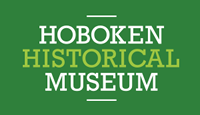Hoboken, New Jersey, The Mile Square City: A Brief History
Lenni Lenape Indians camped seasonally on the marshy island they called “Hopoghan Hackingh,” “Land of the Tobacco Pipe,” for the abundance of green-colored serpentine rock, or soapstone, used to carve pipes for smoking tobacco. Henry Hudson’s navigator, on his ship Half Moon, mentioned the green-veined bluff during the 1609 voyage up the river that now bears the explorer’s name.
The men on the Half Moon were the first Europeans known to have seen the island, soon followed by many other settlers. The Dutch visited in those early years, calling the area “Hoebuck,” or “high bluff,” for the elevation we today call Castle Point. In 1658 Peter Stuyvesant, Dutch Governor of Manhattan, bought all the land between the Hackensack and the Hudson Rivers from the Lenni Lenape for 80 fathoms of wampum, 20 fathoms of cloth, 12 kettles, 6 guns, 2 blankets, 1 double kettle, and half a barrel of beer.
Subsequently the land came into the possession of William Bayard. Because he was a Loyalist Tory in 1776, his land was confiscated by the Revolutionary Government of New Jersey to be sold at public auction. In 1784 Colonel John Stevens of the Patriot Army bought the island for 18,360 pounds sterling, then about $90,000. He settled on the name “Hoboken,” and the Stevens family became an inseparable part of the city’s history. As early as 1820, Stevens began transforming the wild but beautiful waterfront into a recreation area, with New York City dwellers as his market. He constructed a riverfront walk with a refreshing spring water grotto, dubbed Sybil’s Cave, and a large park he named the Elysian Fields, both allusions to Classical mythology. He then launched a ferry service and on weekends, the rustic area surrounding his estate on the bluff soon welcomed as many as 20,000 New Yorkers out for Sunday picnics via sailboat, rowboat, and ferry.
On June 19, 1846, the New York Nine defeated the Knickerbockers, 23 to 1, in the first match game of baseball by Alexander Cartwright’s new rules, widely considered the birth of modern baseball. The Elysian Fields also hosted cricket and football tournaments, spectacles such as P.T. Barnum’s “Grand Buffalo Hunt” in 1843, as well as the earliest feasts of the legendary Turtle Club, founded by Col. Stevens and his good friend Alexander Hamilton, with George Washington as an honorary member. The Colonel’s son John Cox Stevens began America’s first yacht club in Hoboken in 1844; the America’s Cup is named after that club’s racing yacht, America. Fellow New York Yacht Club member, John Jacob Astor, built a summer home at Washington and Second Streets.
Colonel Stevens was an avid horticulturalist and inventor, considerably ahead of his time. He introduced camellias and chrysanthemums to America, and in 1791 he received one of the first patents issued in America, for a steam engine. Thirteen years later, his Little Juliana steamed across the Hudson. In 1808 Colonel Stevens launched the Phoenix, the first steam-driven vessel to make an ocean voyage. Stevens received the first American railroad charter, and by 1826 he designed and built the first experimental steam-driven locomotive in the U.S., running on a circular track in Hoboken. His son Robert Livingston Stevens designed the T-shaped rail, which enabled the rapid expansion of American railroads.
The City of Hoboken was incorporated on March 28, 1855. With its waterfront location opposite New York, Hoboken established itself as a rail and water transportation center, a major port for trans-Atlantic shipping lines, including Holland America, North German Lloyd, and Hamburg-American. In 1917, Hoboken’s facilities and strategic location made it the choice of the Federal government as the primary port of embarkation for troops in World War I.
Most of Hoboken was built in the 19th century to standards set by the Hoboken Land & Improvement Company, created by Stevens in 1838 to manage the development of the city along an orderly street grid punctuated with parks.
By virtue of its role as a gateway to America and the presence of so many small factories, Hoboken grew rapidly from 9,662 in 1860 to 70,324 in 1910. It was the first foothold in the New World for many European immigrants. Germans arrived first, and Hoboken became a Germanspeaking city. After World War I, waves of Irish, Italians, Yugoslavs, Latinos, then South Asians and Indians settled here.
By 1958, containerization of ship cargo doomed Hoboken’s thriving waterfront and over the next two decades, factories began closing and the city suffered the economic decline seen by many Northern industrial cities. In the 1970s, the Johnson administration’s “Model Cities” program channeled low-interest loans to local homeowners and developers to rehabilitate existing housing stock. Hoboken’s well-preserved 19th century charm soon drew new waves of newcomers, first artists and musicians seeking affordable housing near New York’s art scene, followed by waves of suburbanites seeking jobs in booming 1980s New York City.
The mix gives Hoboken a vibrancy and energy rare in a city its size. Sidewalk cafes, interesting shops, period buildings, street fairs, the Hudson River Walkway, and a busy street life combine to make Hoboken a most colorful and distinctive urban Square Mile.
